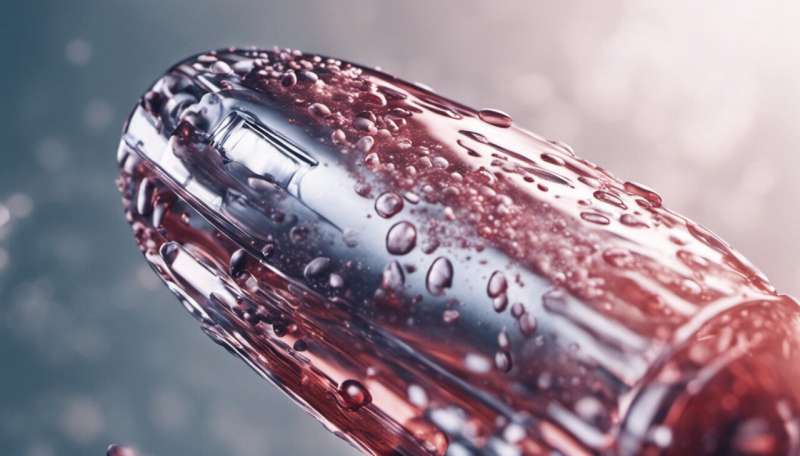This article has been reviewed according to Science X's editorial process and policies. Editors have highlighted the following attributes while ensuring the content's credibility:
fact-checked
trusted source
written by researcher(s)
proofread
Retinol: What is it and why is it considered a modern anti-aging skincare essential?

Of all the wonder ingredients promoted by skincare enthusiasts and manufacturers, retinol is among the most popular. It's a potent ingredient that can help with a wide variety of complaints, from wrinkles to acne. But how does it work and should you just go out and buy the first retinol product you see?
What is retinol?
Retinol is a catch-all term often used to describe vitamin A and other retinoids (a group of fat-soluble compounds consisting of retinol and other structurally related substances). Vitamin A is an essential micronutrient that plays a vital role in supporting various physiological functions in most mammal species. It promotes normal vision, bolsters the immune system, facilitates reproduction and fosters optimal growth and development.
Vitamin A has become popular in skincare because it has been approved by the US Food and Drug Administration as an anti-aging agent that changes the appearance of the skin surface. It can help maintain skin health and, because it stimulates collagen and elastin biosynthesis, it can enhance the skin's regenerative mechanisms. Retinol's antioxidant properties also help protect the skin against the photodamage caused by ultraviolet light, such as from sun exposure.
One of retinol's derivatives, retinoic acid, has also been used for the treatment of skin disorders, such as photodamage, acne vulgaris, wrinkles, psoriasis and hypertrophic scars, keloids, and scleroderma. In my own research, I'm also exploring retinol's potential use in wound healing and the results are so far very promising.
Currently, the retinoid products for cosmetic use can be broadly divided into three categories: retinol (the most well known of the three), retinyl (the more stable form), and retinaldehyde (or retinal, for short). There are structural differences between the three.
Retinol
Retinol was first isolated from the liver oil of the Atlantic saury fish in 1931. The compound is naturally found in animal products and as chemical precursors in fruits and vegetables.
Retinol is a fat-soluble molecule with antioxidant and wound healing ability. When retinol is applied topically, it is converted into retinoic acid by the skin, the biologically active form of vitamin A. Once applied, it acts as a regulator of tissue regeneration, stimulating extracellular matrix (ECM) production of collagen and elastin, which directly addresses various skin concerns including fine lines, wrinkles, uneven skin tone and acne.
When it comes to skincare, retinol is the best option among all the retinoids if a suitable delivery method is used. But it is a sensitive molecule and is highly susceptible to changes in the environment, such as light and oxygen.
That makes it difficult to incorporate into skincare products in a stable and effective formula. This is why you often see retinol skincare products packaged in opaque bottles, which protect them from the sunlight. Some manufacturers recommend keeping retinol products in the fridge, and most skincare retinol products have a limited shelf-life.

Retinyl is a more stable form of vitamin A than retinol. The most common forms are retinyl acetate and retinyl palmitate. Retinyl needs to be converted into retinol and then into retinoic acid by the skin in order to be functional.
Retinyl is a milder form of retinoid compared with retinol, and is often used in skincare products that focus on nourishing and moisturizing the skin, improving skin texture and hydration rather than providing significant anti-aging benefits. Due to its lower potency compared with retinol, it is less irritating to the skin, making it suitable for people with sensitive skin or those new to vitamin A products.
Retinaldehyde
Retinaldehyde, also known as retinal, is more potent than retinol but less potent than retinoic acid. In molecular terms, it is closer to retinoic acid than retinol and requires only one more step of conversion to become biologically active. Due to its proximity to retinoic acid, retinaldehyde is considered more efficient in producing skin benefits compared with retinol.
Retinal has also shown antibacterial properties against some bacteria. However, retinal is more unstable than retinol so it is very challenging to formulate it in a stable formulation, which explains why there are very few retinal cosmetic products on the market.
Which to choose
Retinoid products are available in different strengths, ranging from low to high concentrations. Generally, over-the-counter cosmetic products may contain retinol concentrations ranging from 0.1% to 1%. These concentrations are lower than prescription-strength retinoids, which can contain higher amounts of retinol or more potent derivatives such as tretinoin.
But EU regulation restricts the use of retinol and its equivalents in cosmetics to maximum concentrations of 0.05% in body lotions and 0.3% in hand and face creams and other leave-on or rinse-off products. This is why you might see stronger retinol products on sale in markets such as the US, compared with Europe or countries that trade heavily with Europe.
The retinyl esters are the most stable but have not shown significant differences when used on the skin, compared with a placebo. So, opting for retinol and retinal would lead to better results. But be aware that the instability of these molecules makes them less effective when exposed to light and oxygen, so treat your products with care.
Retinol in conventional formulations doesn't penetrate the skin easily. Novel formulations based on nanotechnology are therefore being developed to overcome the limitations of the conventional formulations, such as their poor penetration, instability and potential to irritate the skin.
For example, nanoemulsions—retinol encapsulated in tiny droplets of less than a few hundred nanometers—have been shown to be more stable and penetrate the skin more effectively. Encapsulated retinol formulations are normally slow-releasing and less irritating. So, look for retinol skincare products with advanced features such as encapsulation delivery systems. These will be more effective.
This article is republished from The Conversation under a Creative Commons license. Read the original article.![]()

















